RAF Woodhall Spa - Past & Present
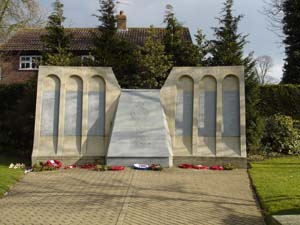
The Dambusters Memorial in Woodhall Spa
RAF Woodhall Spa - The Past
The village of Woodhall Spa is at the heart of what is often referred to as 'Bomber' County. By 1945 and the final months of the 2nd World War the RAF and USAAF were conducting operations from 49 airfields in the county of Lincolnshire, with Avro Lancaster bombers based at half of them. The majority of these bases have long since closed and the land returned to agriculture, but in recent years several have become the home for aviation heritage centres or the site for Squadron memorials including Woodhall Spa.
Two elite squadrons; 617 (the 'Dambusters') Squadron and 627 Squadron, flying Lancasters and Mosquitos respectively, operated from RAF Woodhall Spa in the closing months of the war. The most famous bombing mission of World War 2, the Dams Raid, was carried out by 617 Sqn in 1943, but that was before they relocated from RAF Scampton to Woodhall Spa. Nevertheless, in the annals of RAF Bomber Command some of the most technologically advanced and successful operations were launched by 617 from Woodhall Spa. The sinking of the German battleship 'Tirpitz', and the destruction of the Saumur railway tunnel and Bielefeld railway viaduct amongst the most significant.
Background
The outbreak of WW2 necessitated a massive expansion to the military airfield construction programme which had begun in the mid-1930s. However, the sheer scale of the construction program meant that elaborate and durable design standards had to be sacrificed for speed of construction and basic functionality. As a consequence, wartime airfields were rather austere in comparison to those of the 1930s Expansion Scheme and were comprised primarily of temporary buildings with a predicted life of about 10 years. Barrack accommodation principally consisted of Nissen Huts, the hangars were comprised of prefabricated steel sections erected on site and technical buildings were of single brick thickness and rendered in concrete.
Four hundred and forty-four airfields, complete with paved runways, perimeter tracks and aircraft hard-standings, were constructed for the RAF in the UK between 1939 and 1945. The peak of construction occurred in 1942, when a labour force of sixty thousand men were completing a new airfield, on average, every three days.
Construction
RAF Woodhall Spa was originally conceived as a satellite airfield for RAF Coningsby. It would seem that the land was requisitioned by the Air Ministry in 1940 and construction of the airfield began soon after, however the immediate threat of invasion led to the postponement of all work until 1942. In the meantime, to guard against the potential threat of enemy aircraft landing, the prepared areas were rendered unusable by deliberately ploughing up the ground.
The site chosen for the airfield was primarily flat and open 'fenland edge' farmland sitting 45ft above sea level between the confluence of the Old River Bain and River Witham. On the northern edge of the site the ground gently rose to form the south-westerly tip of the Lincolnshire Wolds. The area was (and is still) comprised of open heathland and forest; the soil and high water table supporting the quick growth of trees, such as Pines and shrubs like Rhododendrons. The airfield construction contractors (unknown at this time) had to fell a significant number of trees to clear the site. Access to the airfield was from the B1192 road at the northern end of Tattershall Thorpe.
RAF Woodhall Spa was built to the Air Ministry 'Class A' specification. Austere and markedly different in layout to those constructed during the pre-war expansion period. The constant risk of fatalities from air attack, aircraft crashes and accidental bomb detonation had necessitated the dispersal of key assets around the countryside taking advantage of the cover provided by trees, hedgerows and folds in the landscape.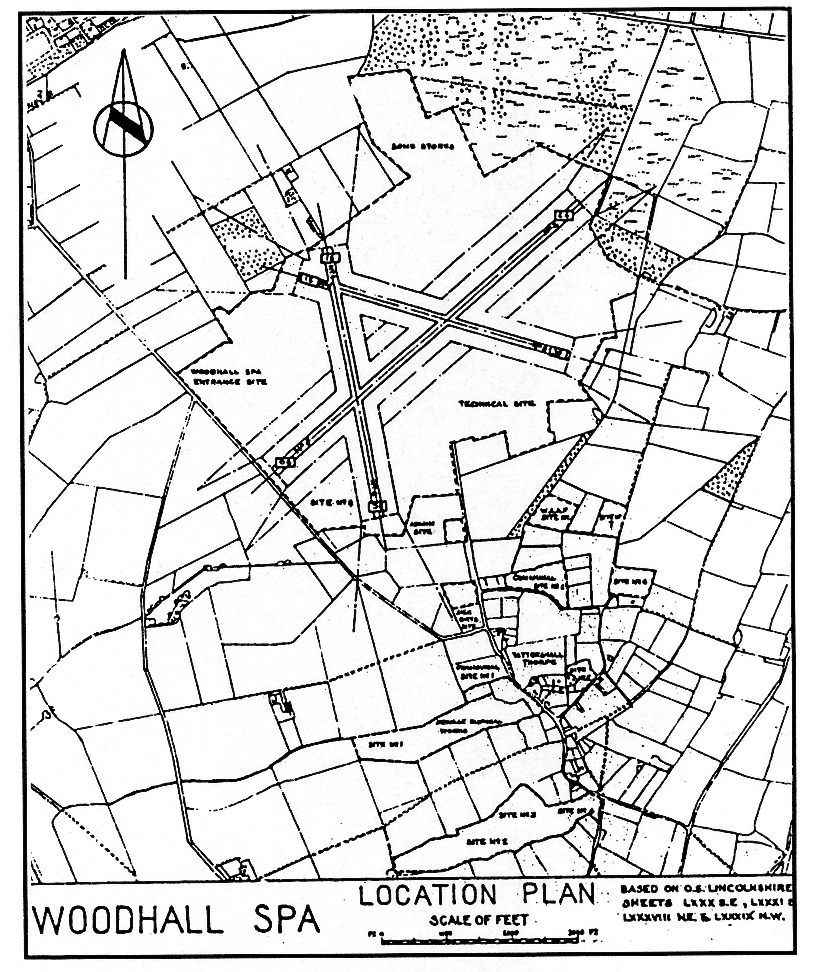
Plan of RAF Woodhall Spa (Courtesy: 627 Sqn in Retirement website)
On the plan Ostler's Plantation is at the top, just right of centre. The road from Woodhall Spa to Tattershall Thorpe runs diagonally down from the top left hand edge and the current RAF Woodhall Spa (2016) is on the left side of the three runway intersections. The main entrance to the airfield and technical site was originally via a track running north from Tattershall Thorpe. Access to the present day RAF Woodhall Spa is off the Tattershall Thorpe-Woodhall Spa road at the south western end of the main runway.
The station finally opened in February 1942 under the control of 5 Group Bomber Command as a satellite of RAF Coningsby. In August 1943 it became No. 54 Base Substation.
An excellent book about RAF Woodhall Spa entitled 'Into Thin Air' was written by Nigel Press and published in 2001. This book is now out of print and hard to come by; nevertheless the aim of this page is to supplement the book, not duplicate it.
Airfield
Three concrete runways were laid in the standard Bomber Command A-frame format. The main runway was 6000 feet long and the two subsidiaries were 4200 feet. A concrete perimeter track linked both ends of all three runways. Linked to the inside and outside of the perimeter track, but scattered randomly around the airfield were thirty-four aircraft hard-standings of 125ft diameter, which enabled the aircraft to be parked well away from each other and thus reduce the risk from air attack. However, there was a period in 1944 when 617 Sqn had 44 Lancasters on strength and 627 Sqn around 18 Mosquitos on strength.
The logistics involved in construction of a typical class A airfield are fascinating; each would consume in the region of 130,000 tons of ballast and cement.
Hangars
In line with the Air Ministry specification three hangars were erected on the airfield; two transportable T2 steel hangars and a Ministry of Aircraft Production (MAP) B1 hangar for the use of civilian repair teams.
Both types of hangar can still be found at various airfields across the country. A Type B1 still stands at the former RAF Grimsby (Waltham) and there is a line of T2 hangars on the opposite side of the road from RAF Barkston Heath airfield.
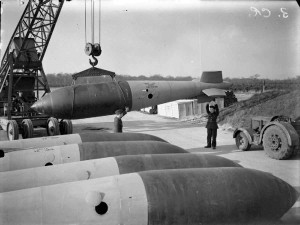
A 'Grand Slam' bomb being lifted onto a trolley in RAF Woodhall Spa bomb dump. This particular bomb was dropped on the railway bridge at Nienburg, Germany by 617 Sqn.
CH 15369
Part of
AIR MINISTRY SECOND WORLD WAR OFFICIAL COLLECTION
Royal Air Force official photographer
Crouch F W (Flt Lt)
Bomb Dump
Three concrete roadways linked the airfield perimeter track to thirty-three bomb storage and arming facilities, dispersed in the trees of Ostler's forestry plantation on the northern edge of the airfield. To mitigate against damage from blast and to assist with camouflaging the bombs, wooded areas were always favoured for airfield bomb stores. High Explosive (HE) bombs of Medium Capacity (MC) and High Capacity (HC), minus tail fins, were stored in the open on a series of raised concrete plinths surrounded by earth revetments designed to contain the blast from accidental bomb detonation and provide a degree of protection from air attack.
Small Arms Ammunition (SAA), incendiary bombs and Small Bomb Carriers (SBC) were stored in a series of 'temporary brick' and 'Nissen' huts dotted around the site.
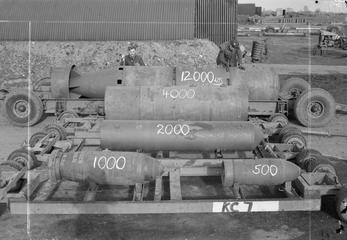
Armourers show off bombs for a comparison in size at the bomb dump at Woodhall Spa, Lincolnshire. In the front are 1,000-lb and 500-lb MC bombs, behind them a 2,000-lb HC Mark I, then a 4,000-lb HC Mark III or Mark IV 'Cookie'. Finally, at the rear, is a 12,000-lb HC 'Blockbuster', essentially three 4,000-lb 'Cookies' bolted together with the addition of a six-finned ballistic tail.
A series of concrete tracks looped through the bomb dump in wide arcs to enable tractor drivers to, safely and simultaneously, tow several laden bomb trolleys from the stores, to one of three fusing points and then out to the aircraft dispersals.
Loading a squadron of 24 Lancasters was undoubtedly a time consuming and labour intensive task for the specialist teams of armourers.
When the storage area specification was originally drawn up its seems very unlikely that the designers envisaged a requirement to store or manoeuvre 22,000lb 'Grand Slam' bombs. However, when the time did come, smaller bombs had to be removed from Woodhall Spa bomb store in order to create sufficient space.
Technical Site
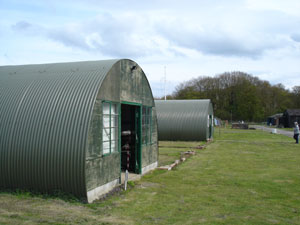
Nissen Huts
The technical site, consisting of more than 70 buildings, was constructed next to the perimeter track on the south side of the airfield. The majority of these buildings would have had a specialist function such as the Watch Office (Control Tower), Station Headquarters, T2 Hangar, Armoury, Photographic section, Radar workshop, Parachute Store, Dingy hut, Link Trainer, Bombing teacher, Motor Transport Offices and garages, Fire Tender House, Bulk Fuel Installations and blast shelters. Virtually all of the buildings have long since been demolished.
Wartime airfield buildings were built to Air Ministry specifications principally from concrete, brick, timber, corrugated iron and asbestos. The majority of brick buildings were of only single brick thickness (4.5-inch brick) laid in stretcher bond, but reinforced with external brick piers set at 10ft intervals. The piers supported steel or timber roof trusses, which invariably were covered in corrugated asbestos sheeting. Nissen huts, were common at Woodhall Spa and served a wide variety of functions on the technical, administrative, accommodation and communal sites.
The Watch Office was brick built and constructed to Air Ministry drawing 15956/40. Unfortunately, the iconic symbol , marking the site of many other former airfields, was demolished in the late 1960s.
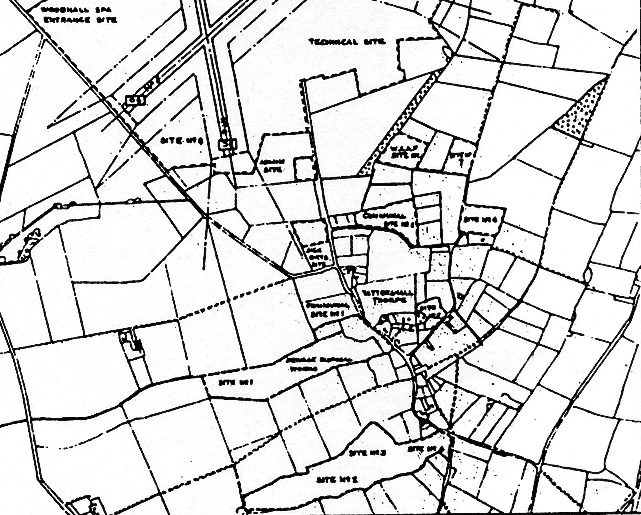
Plan of RAF Woodhall Spa Communal Sites (Courtesy: 627 Sqn in Retirement website)
Dispersed Sites
A number of hutted sites were constructed to accommodate and cater for the two thousand air and ground crew that would be needed to operate a heavy bomber squadron. In common with the aircraft hardstandings they were dispersed around the local countryside taking advantage of woods, hedgerows and dips in the landscape in an attempt to reduce their risk to personnel from air attack. Understandably, the humble bicycle became the main form of transport for airmen transiting between barrack hut, communal site and aircraft dispersal on airfields such as Woodhall Spa.
Administration Site:
The administration site was immediately south of the technical site on the track to Tattershall Thorpe. It comprised either 2 or 3 buildings.
Station Sick Quarters (SSQ).
The SSQ site comprised 10 buildings including the wards, mortuary, ambulance garage, ablutions and staff quarters.
Women's Auxiliary Air Force (WAAF) Site:
This site comprising 18 buildings, catered for all the WAAF Officers, Sergeants and airwomen based at Woodhall Spa, but it was not completed until 1944. Up until that point many of the WAAF's had cycled from more luxurious accommodation at RAF Coningsby.
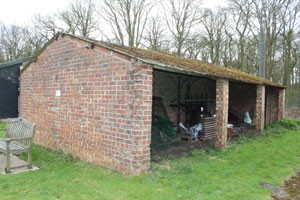
Cycle Shed (Communal Site No 1)
Communal Site No 1.
Communal site No 1 was built amongst the trees at the east end of Tattershall Thorpe Carr Wood alongside the Coningsby-Woodhall Spa road. The site comprised 25 buildings, including an Officer's and Sergeant's Mess, Combined Dining Hall, the NAAFI, a Ration Store, Baths, Latrines and Ablution Blocks.
The Public Service Institute (PSI) was responsible for overseeing the Navy, Army & Air Force Institute (NAAFI). The NAAFI was a non-profit making organisation created by the government in 1921 to provide welfare and amenities for servicemen and women. It ran recreational establishments, sold goods like cigarettes to servicemen and their families, ran bars, clubs and shops. During WW2 it provided over 4,000 artists to entertain the troops. The PSI committee was composed of squadron representatives from around the station. They held regular meetings to approve projects such as special entertainments.
Communal Site 2 - 17 buildings including the Station Commander's quarters, an Airmen's dining room, Sergeant's Mess, gymnasium, squash court, NAAFI, Tailor, barber and shoe maker's shop. The Station Commander's quarters are still standing and now used as a stable.
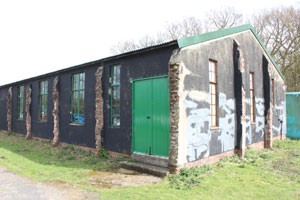
Dwg No 15931/40 - Airmens Baths & Ablutions (Communal Site No1). Temporary brick building with concrete rendering.
Site 1 - Was located in the south-west corner of Tattershall Thorpe Carr Wood and comprised 27 buildings including barrack huts, latrines, drying rooms and ablutions for officer's, sergeant's and airmen.
Sites 2, 3 & 4 - Comprised of 19, 31 and 13 buildings respectively were located in Tattershall Carr Wood immediately south of Tattershall Thorpe and west of the road to Coningsby. The sites included officer's quarters and airmen's barrack hut accommodation and latrines.
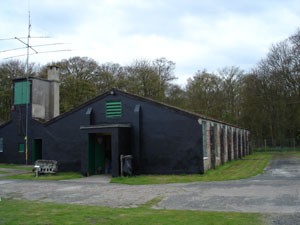
Dining Hall (Communal Site No 1). Temporary brick building.
Sites 5 - Was virtually opposite Communal Site 1 and became the accommodation for 627 Sqn. 32 buildings including officer's, sergeant's and airmen's barrack huts, latrines, drying rooms, ablutions and a fuel compound.
Site 6 & 7 - Were the most easterly of the sites and both comprised 30 buildings of a similar composition to those on Site 5; accommodating officers, sergeants and airmen.
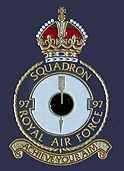
97 Sqn
97 (Straits Settlements) Squadron
97 Squadron relocated from RAF Coningsby to Woodhall Spa on the 2nd of March 1942 and stayed for 13 months. It was transferred from 5 Group to 8 (Pathfinder Force) Group and relocated to RAF Bourn in Cambridgeshire on the 18th of Apr 1943.
It was one of the first Sqns to be equipped with the Avro Lancaster and on the 17th of April 1942, participated in its first major operation (Margin) with 44 Sqn; a rare 2 x 6-ship sortie conducted at tree-top height in daylight on the MAN diesel works in Augsburg. In June and July 1942 it participated in the 1000 bomber raids on Cologne, Bremen and Essen.
97 Sqn Association website: www.97squadronassociation.co.uk/
Section reviewed 26 Dec 20
619 Sqn actually formed at Woodhall Spa on the 18th of April 1943 with a nucleus of three crews purposely left behind by 97 Sqn. Their first mission was flown on the night of the 11th of June 1943, when 12 Lancasters were sent to bomb targets in Düsseldorf. The Sqn relocated to RAF Coningsby on the 10th of January 1944 and were replaced the same month by 617 Squadron. Before the war was over the Sqn had relocated three times, to the Lincolnshire bases of Dunholme Lodge, Strubby and Skellingthorpe.
Section reviewed 26 Dec 20
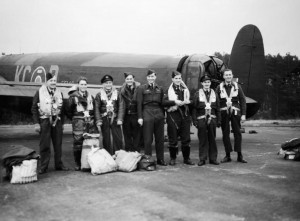 617 Squadron
617 Squadron
617 Squadron was formed at Scampton on 21 March 1943 to perform one specific operation (Chastise) the breaching of the Mohne, Eder, Sorpe and Schwelme dams in the upper Ruhr valley. Lancaster crews were hand picked by the unit's Commanding Officer (Guy Gibson) even though he himself was unaware of the target at the time. The dams were to be breached by releasing a bouncing bomb (mine) at exactly 60 feet above the water and at a speed of 220 mph. The attack was carried out by nineteen specially modified Lancasters on the night of 16/17 May 1943. The Mohne and Eder dams were breached, but the attacks on the Sorpe and Schwelme failed.
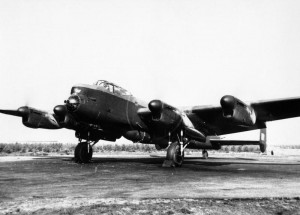
An Avro Lancaster B Mark 1 (Special) of No. 617 Squadron RAF, loaded with a 22,000-lb MC deep-penetration bomb (Bomber Command executive code word 'Grand Slam'), running an engine test in its dispersal at Woodhall Spa, Lincolnshire.
After Chastise 617 Sqn was retained to carry out highly specialised attacks, many of which employed the 12,000lb 'Tallboy' and 22,000lb 'Grand Slam' bombs.
The Sqn relocated to Coningsby in August 1943 and then Woodhall Spa in Jan 1944. The Sqn stayed at Woodhall until the end of the war and conducted many notable missions during that time.
It was with Tallboy bombs that 617 and 9 Sqn sank the Tirpitz in a Norwegian Fiord. The last wartime operation by 617 was on April 25th 1945 against Hitler's holiday home; The Eagles Nest at Berchtesgaden.
The Avro Lancaster of the Battle of Britain Memorial Flight is currently (2016) sporting the 617 Sqn markings and nose art of 'Thumper III'.
TallBoys and Grand Slam
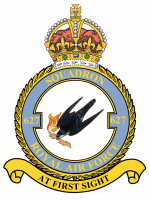 627 Squadron
627 Squadron
This De Havilland Mosquito Sqn was in existence for less than two years; from 1943 to 1945. 627 Sqn was transferred from RAF Oakington and No8 Pathfinder Group to RAF Woodhall Spa and 5 Group in April 1944. The Squadron's new role was low level precision marking of the target with coloured flares in preparation for the arrival of the main force of heavy bombers. The two Lancaster Sqns (83 & 97) based at RAF Coningsby were Pathfinder units whose role was to illuminate the target with flares from high level, to aid 627 with their precision marking.
The Mosquito was originally designed as a light bomber with the speed to outrun enemy fighters and built entirely of wood. It became one of the RAF's most versatile aircraft and earned the name the 'Wooden Wonder'. By the end of the war it had also excelled in roles as diverse as photographic reconnaissance, anti-shipping strike and night fighter. In all, between 1941 and 1950 7,781 were produced by woodworking firms across Britain and in Canada and Australia. There are now (2016) two airworthy Mosquitos, but unfortunately they are both on the western side of the Atlantic Ocean. However, the 'People's Mosquito' project aims to return one to flight in the UK over the next two or three years. The Mosquito on display at RAF Museum Cosford is painted in the colours of a 627 Squadron Mosquito XX, code 'AZ-E', in which Wing Commander Guy Gibson was killed on a pathfinder sortie, the night of 19/20 Sep 1944.

Sergeants Jim Marshallsay and Nick Ranshaw with ground crew in front of their "pet" aircraft at RAF Woodhall Spa (Courtesy of and Copyright © 1943-2012; 627 Squadron in Retirement)
627 operated from the two hangars and dispersals in the north-west corner of the airfield (the T2 hangar for maintenance and the B1 for aircraft storage). As there was a severe shortage of experienced ground crew at the time a compromise was struck between safe dispersal of aircraft and convenience for maintenance. The Mosquito's were parked three to a dispersal on a total of six dispersals, with the rest of the aircraft parked on hangar aprons when necessary.
The Eagle Lodge Hotel in Woodhall Spa (now Inn at Woodhall Spa) served as the Officer's Mess.
Les Seagrave, an engine fitter hailing from Lincoln recalls:
“A” Flight’s end dispersal pan (Aircraft “A“ “B” and ““C”) stretched out into a field, annually sown with linseed or corn. Alongside the pan was a very convenient hedge and path which ultimately lead to the B1192 to Woodhall Spa town, all this out of sight of the Flight Office and its main incumbent, Chiefie Taylor, or Jock to most people.
The mid-morning routine at this dispersal was for the unofficial duty “Bun Runner” to shed overalls, leap on bike along the above mentioned path and collect cakes, buns or whatever the good lady in the bakers (third shop on left before crossroads) could let us have. Return was by the same “secret route”. These items seemed much more attractive than the NAAFI wads dispensed from the mobile canteen, if indeed there were any left after the van had been round 617 Squadron’s dispersal first, which was the rule rather than the exception.
This daily operation was a very well kept secret - no one else knew! One day in mid- summer 1944 Chiefy Taylor had occasion to spend some considerable time investigating, with us, a hydraulic fault on “A” Apple. Came 10.00hrs and the dispersal crew was asked quite calmly and seriously by the said Chief ‘Isn’t anyone going to Woodhall for the buns this morning? I’m hungry and I’m having my char with you lads if you have no objection’ (Sorry, the Scots accent does not come out in print). Such are the best kept secrets!
Seagrave, L. (....) At First Sight - Posted Almost To The Doorstep. Reproduced from the 627 Sqn in Retirement website with the kind permission of the site administrator.
The first two and a half minutes of this amateur film were shot by 627 Sqn Navigator Brian Harris DFC in Aug 1944 (Note: the 627 Sqn tail code of 'AZ'). Pilot for the airborne shots was Pilot Officer Johnny Thomson DFC. Clips from before, during and after the Squadron's pathfinder attack on the German airfield of Deelen in Occupied Holland on 15 August 1944. Before the raid preparation scenes at Woodhall Spa airfield, Lincolnshire, plus low-level aerial views of Cambridge, Skegness, Lincoln Cathedral and Boston Stump Church Tower. This clip is from the "RCAF/RAF Aircraft at War" DVD.
627 Sqn in Retirement is an excellent website with many stories from air and ground crew veterans of the Squadron.
Operation Market Garden
In the latter half of 1943 units of the 1st Airlanding Brigade began to arrive in Woodhall Spa. The Brigade was part of the 1st Airborne Division and destined to participate in the ill-fated Operation Market Garden; the attempt to seize a series of bridges across the Meuse and Rhine leading to the Dutch town of Arnhem. The Brigade, which comprised three infantry battalions (1st Battalion Border Regiment, 2nd Battalion South Staffordshire Regiment and 7th Battalion King's Own Scottish Borderers) along with supporting units, requisitioned hotels, billeted soldiers in boarding houses and officers with local families and occupied hutted camps on Roughton Moor, just a few hundred yards from RAF Woodhall Spa and to the east of the village.
During the months leading up to the Operation the troops re-equipped and trained in the local area for a glider borne assault. On the 17th of September they were airborne and their destination was Arnhem. The fierce fighting which ensued over the following days is the subject of many books and the movie 'A Bridge To Far'. Operation Market Garden failed to secure a foothold over the Rhine and ended Allied expectations of finishing the war by Christmas 1944. The majority of the airborne troops who landed north of the Rhine were either killed or captured and only a small percentage managed to escape.
Many of those from the 1st Air Landing Brigade that did escape were taken to Brussels airfield on the 29th of September and flown to RAF Woodhall Spa.
Tiger Force
After victory in Europe RAF Woodhall Spa became one of several assembly and kitting out points for Tiger Force (the proposed heavy bomber force to join the war against Japan). The dropping of two atomic bombs on Japan negated this plan. After the end of the Second World War and with the move of No. 617 Squadron RAF to the more permanent facilities of RAF Waddington the airfield was closed and the site used by No. 92 Maintenance Unit for the storage of bombs.
Post war
In 1959 the northwest corner of the airfield, centred on the hangar and hard standings once occupied by 627 Sqn, was fenced off and reactivated as a Bristol Bloodhound Surface to Air Missile (SAM) base under the control of 222 Sqn. Control of the Bloodhounds passed to 112 Sqn in late 1964 and then, in 1967, the entire Sqn moved to Cyprus.
Since then the former missile site has been under the control of RAF Coningsby and used by the station for various purposes including housing the Police Dog Flight, storage space for the Supply Squadron and testing and maintenance of McDonnell Douglas Phantom and Panavia Tornado engines.
At some point in the 1960's the rest of the airfield was sold off for agricultural use and sand/gravel extraction. Most of the concrete from the runways, perimeter track and hard standings was broken up and taken away to be used as hardcore on one road building project or another.
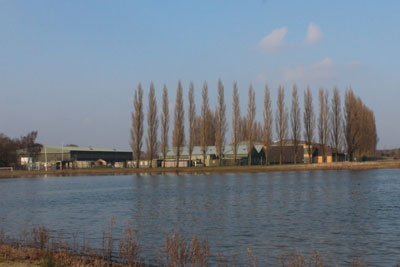
RAF Woodhall Spa. Photo taken from perimeter track near south-western end on main runway (Author's collection - 2016)
The lower Bain river valley is dotted with worked out and flooded sand and gravel pits. They are now home to nature reserves, holiday parks and even a council tip. In the forty or so years since the airfield was sold off the sand and gravel lying just below the surface has been removed in the same fashion. The site is now exhausted, so the quarrying company landscaped the area and allowed the pits to flood to create a haven for wildlife. The Lincolnshire Wildlife Trust purchased the quarried area and created a wildlife reserve, whilst retaining the runway intersection once occupied by the quarry plant as a lasting memorial to its past. Only the north-western part of the airfield technical site remains, a hangover from the Bloodhound missile days, but it is still used by the RAF and BAE Systems to support aircraft maintenance activities at RAF Coningsby.
RAF Woodhall Spa - Present (2016)
Very little of the former airfield can be seen: the concrete runways were broken up and used elsewhere for hardcore prior to decades of sand and gravel extraction, which has only recently come to an end. Two key areas have survived; the former Bloodhound missile site in the north-west corner, which has been retained by RAF Coningsby as a storage site, and the intersection of the main and secondary runway upon which the quarrying plant was once located.
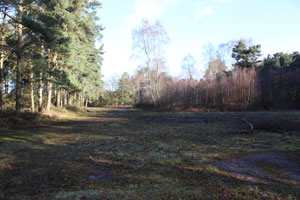
A moss covered dispersal in Ostler's plantation
Aircraft Hardstandings (dispersals) today
Four out of the original hard-standings, in the north-eastern corner of the airfield, have survived simply because they are now on Forestry Commission land in Ostler's Plantation. The moss covered concrete is slowly crumbling and self-seeded trees are growing in the cracks between the slabs. Mature trees, butting up to the edge of the concrete, clearly mark the edge of the hardstandings. Set into the concrete at the centre of each hardstanding is an iron loop and this is surrounded by six more equally spaced at a radius of 15 feet from the centre. The loops were used to picket the aircraft when strong winds were forecast.

Stanton Shelter Entrance
In the woods to the east of the hardstandings a Stanton Air Raid Shelter, built for the protection of the airmen maintaining the dispersed aircraft, can be found. These shelters were manufactured by the Stanton Ironworks Co Ltd near Nottingham. They could be built to any length but they usually consisted of 18 precast concrete arched-shaped units (each one in two parts), which were bolted together to form a standard Air Ministry shelter.
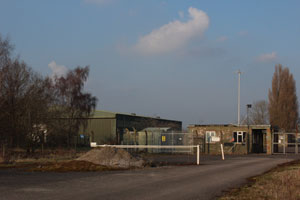
Hangar and present day RAF Woodhall Spa
Hangar
One of the T2 hangars still stands on its original site having been incorporated in the Bloodhound missile site of the 1950's and retained as part of the present RAF Woodhall Spa complex.
A number of other buildings accompany the hangar, which date back to its use as a missile site.
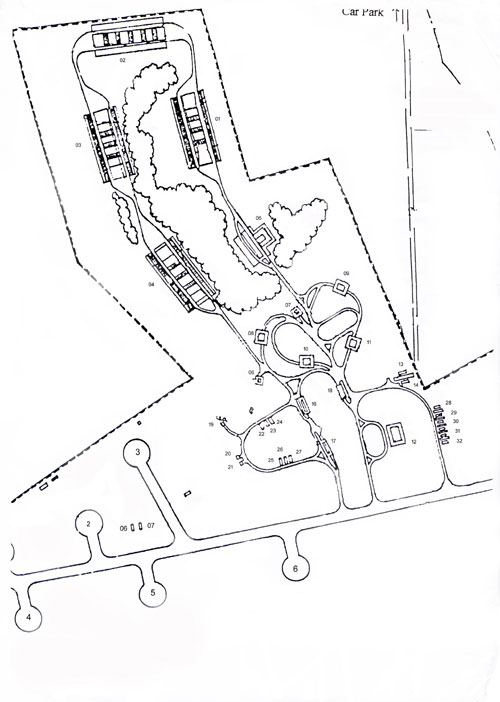
RAF Woodhall Spa Bomb Store
Bomb Store
The Forestry Commission purchased the 300 acre Ostler's Plantation the late 1940's. The Plantation is bounded on its southern edge by a narrow strip of the airfield perimeter track
As a result the concrete tracks and storage areas of the bomb dump now lie within the plantation and, although much decayed and overgrown, can still be seen. The Plantation is open to the public and a car park is provided just inside the main entrance on the Woodhall Spa to Kirkby on Bain road.
To find the airfield perimeter track, access the plantation by the main entrance and continue straight on. You will reach the edge of the plantation and a rabbit fence after approx 400 yards. You are now standing on the concrete of a much narrowed perimeter track.
See if you can find all the bomb storage areas using the plan to the right as a reference. The frying pan shaped hard-standings/dispersals numbered 2 to 6 have long since been broken up and the concrete used for hardcore on some distant road construction project, but virtually all the bomb dump storage sites can still be located. Some of the buildings have been demolished or dismantled (presumably by the Forestry Commission), one of two have simply collapsed and the earth blast walls are disguised by brambles and mature trees.
A description of the layout, construction materials and original purpose of each store is described below. The store numbers can be cross-referenced to the plan above:
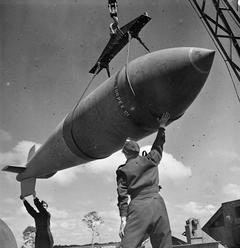
© IWM (CH 15363)
A 12,000-lb MC deep-penetration bomb (Bomber Command executive codeword 'Tallboy') is hoisted from the bomb dump to its carrier at Woodhall Spa, Lincolnshire, to be loaded into an Avro Lancaster of No. 617 Squadron RAF for a raid on the V-weapon site at Wizernes, France, 22 June 1944. 617 Squadron were unable to bomb the target on this occasion because of low cloud cover, but were to succeed two days later.
Store 1. Bomb stores (With tail unit) Type 'D' 200 tons - 3144/42
Store 1 was a slightly earlier version of stores 2, 3 and 4, described in the next section.
Stores 2, 3 & 4. Bomb stores (With tail unit) Type 'D' 200 tons - 557/43. (see figure 1)
Stores 1, 2, 3 and 4 were open air storage areas for large bombs. Each store comprised a row of four concrete hard-standings; 6 inches in height high, 24 feet wide and 48 feet in depth. The hardstandings are set 36 feet apart and separated by 6ft high, 50ft long earth revetments (blast walls). Earth revetments also enclose the end of each row. A concrete track runs down each side of the store to permit delivery and collection of the bombs. Earth revetments also run along the entire length of each store on the outside of each track, so that the blast from the accidental detonation of a bomb is completely contained.
All four stores are backed by a 2ft 6 inch high brick wall running the entire length of the row. Set into the wall at regular intervals are iron pegs retaining iron rings (nine rings per bay) for the purpose of securing tarpaulins and/or camouflage netting over the bombs. On top of the brick wall is a 3 feet wide concrete unloading platform. A concrete ramp, 9 foot in depth, runs down from the platform to the 6 inch high concrete hardstanding in each bay. This type of open bomb store was designed for efficiency in loading and unloading and was typical of bomber airfields constructed from late 1941 onwards.
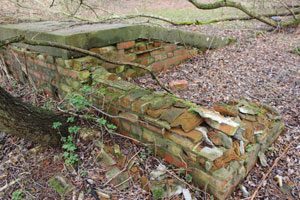
Store 4. Unloading ramp (author's collection - 2016)
Lorries delivering to stores 1, 3 and 4 would pull up alongside the unloading ramp on the west side of store. The bombs could then be rolled down the ramp onto the concrete base or, in the case of the larger bombs, lowered down with ropes. Armourers tasked with re-arming an aircraft would collect the bombs from the east side of the stores; loading them onto tractor hauled trolleys and towing them to the fusing point. Bomb store 2 was of exactly the same design as 3 and 4, but aligned east-west. The lorry unloading ramp is very visible on the south side of the store.

Bomb Store
Lorries laden with bombs arriving at RAF Woodhall Spa were likely to have made the short journey from RAF Market Stainton. The village of Market Stainton was at the hub of a vast storage area in the Lincolnshire Wolds, which was in actual fact the wide grass verges of numerous lanes in the surrounding countryside. Thousands of tons of bombs were stored in this way having arrived at Donington on Bain railway station on the now disused Bardney to Louth line. Tumby Woodside railway station on the 'New Line' was also equipped to handle bombs, so it is possible that they were collected from there. The Tallboy bombs are likely to have been transported direct from the factory to airfield by road and unloaded by crane. Tail units for the 'Tall Boy' and 'Grand Slam' bombs were delivered in wooden crates and stored on the concrete manoeuvring areas alongside bomb stores 1, 2, 3 and 4.
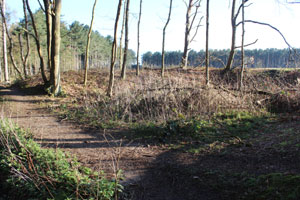
Bomb Store 5
Store 5. Fused and spare bomb store - 4780/42
Bombs returned to the site unused were brought to Store 5 for defusing before being returned to stores 1, 2, 3 or 4. This store is very easily missed as you walk along the concrete track because the earth blast walls have much reduced in height through erosion and are disguised by the cover of thick vegetation and mature, self-seeded trees.
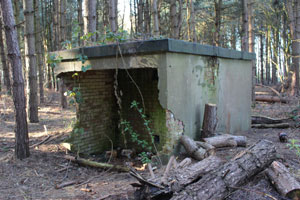
Store 6. Component Store
Store 6. Component store Type 'B' - 4733/42
Store 6 is a 'temporary brick' building, 10 foot wide and 15 foot in depth. Although still standing, most of the front wall has collapsed. A brick wall splits the building into two, unconnected, rooms. Bomb fuses and detonators were once stored here.
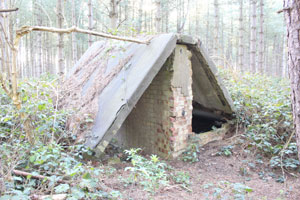
Store 7. Component Store
Store 7. Component stores - 18185/40
Store 7 served exactly the same purpose as store 6, but was built to the earlier 1940 design. One internal wall of this building still stands and the reinforced concrete roof has broke its back, collapsing either side of it.
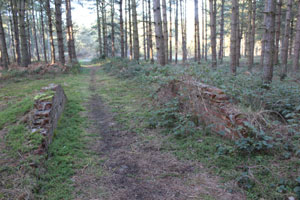
Store 11. Blast wall retaining wall
Stores 8, 9, 10 & 11. Incendiary bomb stores Type 'C'.
These stores were open concrete hardstandings once enclosed by rectangular shaped earth blast walls. The blast walls were probably levelled by the Forestry Commission, but the brick walls built to retain the earth on either side of the track leading into stores 9 and 11, are still standing.
The incendiary bombs stored here would have been of the 4lb or 30lb type. The 4 lb incendiary bomb was used by Bomber Command aircraft in very large numbers. It was the weapon of choice for the British "dehousing" plan for Germany. The bomb was a simple device consisting of a hollow hexagonal cross-section body made from magnesium-zinc alloy with a cast iron/steel nose, filled with thermite incendiary pellets. It burned fiercely for up to 10 minutes once the pellets within the case were ignited by an impact fuse located in nose. The bomb was approximately 2 inches in diameter and 24 inches long. Eight inches at the tail end of the body were hollow, to ensure that the bomb fell nose first.
On the night of 13/14 February a force of 254 Lancasters dropped 500 tons of high explosive bombs and 375 tons of incendiaries on the city of Dresden. This tonnage equated to 200,000 individual incendiary bombs in all. Three hours later 529 Lancasters loaded with the same H.E incendiary mix dropped more than 1,800 tons of bombs. The resultant firestorm is estimated to have killed between 22,000 and 25,000 people.
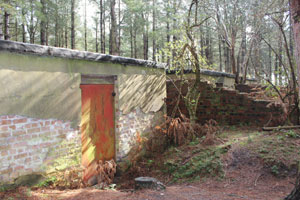
Site 12. Pyrotechnic and Incendiary Stores
Store 12. Incendiary & Pyrotechnic stores
The stores are comprised of three temporary brick, concrete rendered buildings with reinforced concrete slab roofs. A brick wall separates each building and an earth blast wall surrounds the group.
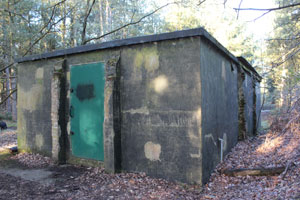
Store 14. Incendiary Stores
Stores 13, 14 & 15. Incendiary stores Type 'D'
Stores 13 and 14 are temporary brick buildings located alongside each other. Both are still in good condition and one is used by a local Archery club to store its targets. Store 15 sits alone on the western side of the site and is also still standing.
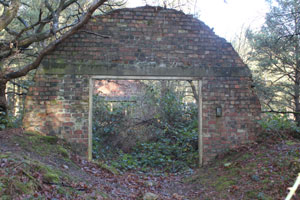
Ultra Heavy
Store 16. Fusing point building (ultra heavy) 4735/42
Store 16 was a drive-through, 16ft wide and 40ft long Nissen hut with brick end walls. The end walls still stand, but the corrugated iron roof has long gone. 60ft long earth blast walls, which at one time butted up against the hut walls are still present (Figure 2).
Paperwork detailing the bomb quantity, bomb fuse type and fuse setting would be delivered to the store in readiness for the arrival of the bombs. The bomb trolleys would be towed into the Nissen hut where the armourers would fit and set the bomb fuses in accordance with instructions. Once fusing was complete the bombs were towed around the airfield perimeter track to the aircraft dispersal.

Fig 2. Store 16 - Fusing point building (ultra heavy) 4735/42
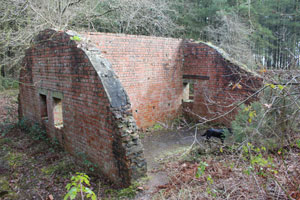
Fusing point (ultra heavy) - inside the earth blast wall
Store 17. Fusing point building (ultra heavy) 4735/41.
This was a originally a drive through Nissen hut with brick end walls and corrugated iron roof. The building could accommodate a bomb trolley 'train' of High Explosive (HE) bombs under cover where the fuses were added, having been collected from the Component stores. The Nissen Hut was enclosed with earth blast walls on both sides and brick walls at each end. However, at some point after the war it was modified for purposes unknown. It may have been modified to meet the needs of the RAF Wickenby based No 92 maintenance Unit, which stored bombs on this site in the year's immediately after the war. Vehicle entry to the store, post modification, would have been impossible.

Fig 3. Store 17 - Fusing point building (ultra heavy) 4735/41.
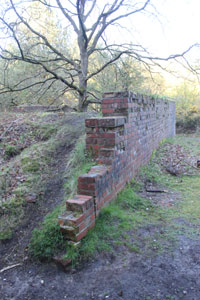
Store 18
18. Fusing point building (Heavy) 15963/40
Like store 17, store 18 does not conform to the original Air Ministry drawing. At some point after the war it appears to have been modified, but the reasons are unknown at this time.
The modified store comprises two parallel, but offset, 6 foot high and 180 foot long earth blast walls, terminated at both ends by a six foot high brick wall of three brick thickness. In common with the modified store 17, the position of the walls prevents tractor and trailer access.

Fig 4. Store 18 - Fusing point building (Heavy) 15963/40

Store 19 - Flame Float Store
Store 19. Flame float store Type 'D' 12725/41
Store 19 is a 'temporary brick building' and still standing. Flame floats were small incendiary devices that were dropped down the aircraft flare chute by a crew member. The flares floated on water and continued to burn brightly. The rear gunner could center his gunsight on the burning flare and then, using a scale on his turret ring, measure and report the angle of offset (deviation) from the aircraft centreline, to the navigator. This deviation would equate to the angle of aircraft drift caused by a crosswind and, when combined with true airspeed and heading, enabled the navigator to calculate track across the ground and position.
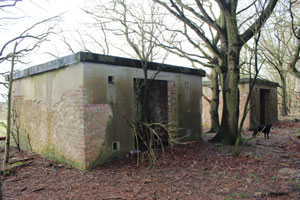
Stores 20 & 21 Small Arms Ammunition Stores
Stores 20 & 21. Small Arms Ammunition (SAA) and Ground Defence Stores 12725/41.
Stores 20 and 21 are 'temporary brick' buildings on the western side of the site and are still standing. They would have held .303 ammunition for the Browning machine guns fitted in the tail, dorsal and nose gun turrets of the Lancaster and the Lee-Enfield rifles of the airfield defence force. Most marks of Lancaster were equipped with 8 machine guns, whereas the pathfinder Mosquito's of 627 Sqn carried no defensive armament at all.
Stores 22, 23, 24, 25, 26 & 27. Small Bomb Container (SBC) store 11065/42.
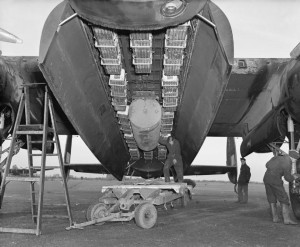 Stores 22 to 27 were two rows of three (16 foot wide) Nissen huts. All have long since been dismantled and removed from the site.
Stores 22 to 27 were two rows of three (16 foot wide) Nissen huts. All have long since been dismantled and removed from the site.
Incendiary bombs were carried in the aircraft bomb bay in open aluminum boxes called Small Bomb Containers (SBC). A SBC could carry 236 x 4lb incendiaries, which were stacked in rows of five, six rows deep and typically three stacks per SBC. The bombs were held in place by bars which were hinged at one end and electrically latched at the other end. The SBC was fitted in the bomb bay inverted so that when triggered, the bar latch was released and the incendiaries dropped en masse. A typical load for a Lancaster comprised one high explosive 4000 lb 'Cookie' bomb and twelve SBCs, each containing 4lb incendiaries or 24 x 30lb incendiaries. The empty SBCs remained in the aircraft bomb bay and on return to base were unloaded, checked and refilled by the armourers. During the course of the war the RAF dropped in excess of eight million 4 lb incendiaries.
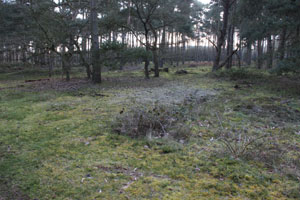
Store 31. The tell tale signs of concrete foundations .
Stores 28, 29, 30, 31, 32 & 33. SBC Stores 6808/42.
Stores 28-33 were a single row of six (16 foot wide) Nissen huts. They have long since been dismantled and removed from the site. The moss and lichen covered concrete foundations, complete with mounting bolts for securing the prefabricated steel sections, are easy to locate amongst the brambles.

Communal Site No.1 - Dining Hall
No.1 Communal Site today
No1 Communal Site was built to the south-west of the airfield in the woods at the northern end of Tattershall Thorpe village and conveniently close to the Blue Bell Inn. After the war, the site was taken over by Horncastle Rural District Council who used it for temporary housing until the 1960s. By the late 1980s it was derelict, and likely to be knocked down, until the Thorpe Camp Preservation Group, a registered charity, first leased and then bought a section of the site. They opened the Thorpe Camp Visitor Centre with museum exhibits in several of the refurbished buildings. The former Airmen's Dining Hall, Navy, Army & Air Force Institute (NAAFI), Cycle Shed, Ablution Block, Ration Store and Work Services huts are now all part of the visitor centre.
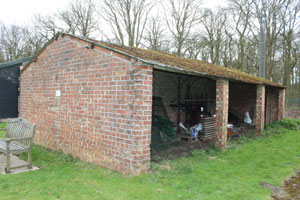
Communal Site No.1 - Cycle Shed
Thorpe Camp Visitor Centre is an excellent little museum principally dedicated to preserving the history of RAF Woodhall Spa and the squadrons that operated from it. However, it also has displays covering the history of aviation in Lincolnshire, the Lincolnshire based Sqns of the Air Training Corps and the Arnhem bound 1st Airlanding Brigade:

Communal Site No.1 - Work Services Nissen Huts
The battered temporary brick shells of the Officer's and Sergeant's messes, baths, ablutions and latrines in the woods immediately south of the museum were demolished in 2019.
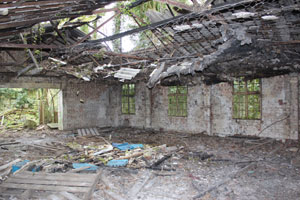
No.1 Communal Site - Sergeant's Mess
Within the south-western edge of the woods are the remains of the 'all ranks' No 1 accommodation site. The concrete foundations of numerous Nissen huts are visible, in addition to sewage ejector houses, concrete tracks and transformer bases. A couple of Stanton Air Raid Shelters still stand and are still in good condition enabling their conversion by the Woodland Trust into hibernaculum for the eight bat resident species.
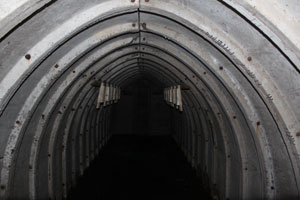
Interior of Stanton Air Raid Shelter
In the centre of the wood a large pile of concrete rubble overgrown with brambles marks the site of the sewage treatment works which was built to service the communal and accommodation sites on the fringes of the wood.
Both Tattershall Thorpe Carr and Tattershall Carr are owned and managed by the Woodland Trust. The woodlands are designated Sites of Special Scientific Interest (SSSI) and are the last remaining remnants of ancient, wet, alder-dominated woodland that once ringed the margins of the Fens. There are a variety of tree species within the woodlands including alder, ash, sycamore, birch, oak, rowan, holly and hazel. The woods are linked by a footpath across the fields at their western end.
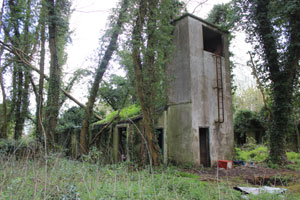
Communal Site No.1 - Officers Mess watertower
617 Sqn Officer's Mess today
During the war the Petwood Hotel in Woodhall Spa served as the Officer's Mess for 617 Sqn. The Sqn bar retains its original furnishings and a wide range of Sqn artifacts and photographs can now be viewed in this room.
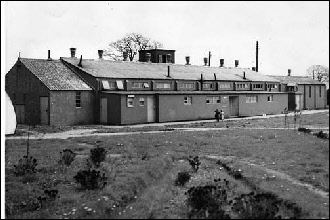
RAF Woodhall Spa Gymnasium
No2 Communal Site today
All the structures on No2 site have long since been demolished or dismantled and relocated. The Gymnasium was one of those relocated buildings:
The Gymnasium
RAF Woodhall Spa Gymnasium on its original site (Cottage Museum)
In Woodhall Spa village a committee was formed in August 1946 and set about raising money to build a Community Centre. By February 1950 they had raised £702 and chosen to purchase and relocate the surplus RAF Woodhall Spa Gymnasium/Theatre from No2 Communal Site to the former Victoria Hotel gardens (destroyed by fire on Easter Day, 1920).
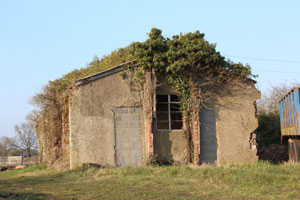
RAF Woodhall Spa Station Commander's quarters
The gymnasium was dismantled, moved and reassembled in Woodhall Spa village. It is now known as Coronation Hall and is host to a wide variety of community events.
RAF Woodhall Spa Station Commander's quarters (author's collection - 2016)
The 'temporary brick' Station Commander's quarters are still standing on their original site, although they do look the worse for wear. They are now on private land and appear to be used used as stables.
Station Sick Quarters (SSQ) today
SSQ was for many years after the war the home of Spa Knitwear Limited. As the business expanded some of the original buildings were enlarged and even built over. Scores were employed by the firm (mostly women) and many were bussed in from as far as Boston. However, in 1972 serious fears of its closure began to emerge.
Article in the Horncastle News - Monday 29 October 2007
The local MP, Peter Tapsell, met workers and assured them he would go to the 'top of the tree' in an effort to clarify the situation. His efforts and their protests continued but soon there was talk of redundancy deals at the knitwear factory, although work continued at the site's Tattershall Lingerie factory, which was running a recruitment drive.
Only 10 of the 100 employees to be made redundant said they would be willing to join the lingerie section.
The site is now largely occupied by private housing although one Nissen hut still stands.
In summary, the majority of wartime airfields have a short yet fascinating history, but with several hundred scattered across the UK in various states of decay it is unreasonable to expect them all to be preserved. The monetary value of the glacial deposits of sand and gravel beneath RAF Woodhall Spa sealed its fate at a very early stage, however we can be considered fortunate in that its legacy is preserved by Thorpe Camp Visitor Centre, the Cottage Museum, Petwood Hotel and the Dambusters Memorial. Not only that, but there is now a Nature Reserve managed by Lincolnshire Wildlife Trust, centred on the runway intersection; a far better outcome for our aviation heritage than a poultry farm or industrial estate.
Can you add to the story of RAF Woodhall Spa airfield?
Do you perhaps know the location of one of the dismantled buildings?
Do you have any photographs of the airfield and its buildings?
If so, please contact the site administrator use the form in the right margin.
© N.R Storey - Woodhall Spa Community website.
Reviewed 26 Dec 20
| Title | Author | First Published | Publisher | ISBN |
|---|---|---|---|---|
| Into Thin Air - the Story of a Bomber Station at War. RAF Woodhall Spa 1941 - 1945 | Nigel Press | 2001 | Tucann Design & Print | 1 873257 17 1 |
| The Airfields of Lincolnshire since 1912 | Ron Blake, Mike Hodgson, Bill Taylor | 1984 | Midland Counties Publications, Leicester | 0 904597 32 6 |
| Lincolnshire Airfields in the Second World War | Patrick Otter | 1996 | Countryside Books | 1 85306 424 6 |
| Defending Lincolnshire | Mike Osborne | 2010 | The History Press, Stroud | 978 0 7524 5399 6 |
| Lincolnshire Air War 1939-1945 | S Finn | 1973 | Aero Litho Company, Lincoln | |
| The Development and Construction of Airfields and Runways for the Royal Air Force, 1939-1945? in The Civil Engineer in War: A Symposium of papers on war-time engineering problems, Volume 1 - Airfield, roads, railways, and Bridges. London: The ICE. | Philip Gordon Hudson | 2015 | ICE Publishing | |
| Nine Thousand Miles of Concrete: A review of Second World War temporary airfields in England. | Research by Paul Francis, Richard Flagg, Graham Crisp | 2016 | Historic England | |
| Bomber Harris: Sir Arthur Harris' Despatches on War Operations 1942-1945 | John Grehan, Martin Mace | 2014 | Pen & Sword Aviation | 9781 78303 298 3 |
| RAF Bomber Airfields of World War 2 | Jonathan Falconer | 1992 | Ian Allan Ltd | 0 7110 2080 9 |
| British Airfield Buildings of the Second World War | Graham Buchan Innes | 1995 | Graham Buchan Innes | 978 0 9561717 0 2 |
| Website name | URL | Feature |
|---|---|---|
| RAF Lincolnshire Info: | www.raf-lincolnshire.info.htm | RAF Woodhall Spa |
| Woodland Trust | www.woodlandtrust.org.uk/visiting-woods/wood/4292/tattershall-carrs/ | Tattershall Carrs |
| Pillbox Study Group | www.pillbox-study-group.org.uk/ | Stanton Air Raid Shelter |
| Coronation Hall | www.coronationhall.co.uk.html | |
| The People's Mosquito | www.peoplesmosquito.org.uk/ | |
| Thorpe Camp Visitor Centre | Website: http://thorpecamp.wix.com/visitorscentre | |
| Aviation Trails | https://aviationtrails.wordpress.com/ | |
| Bomber County Aviation Resource | www.bcar.org.uk/woodhall-history | |
| Lincolnshire Wildlife Trust | www.lincstrust.org.uk/woodhall-airfield-appeal |
